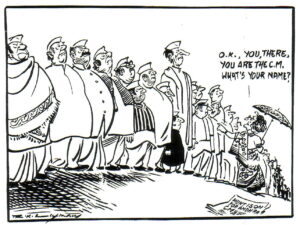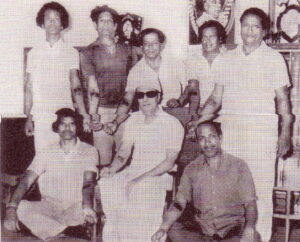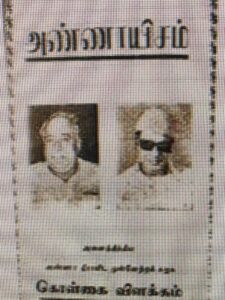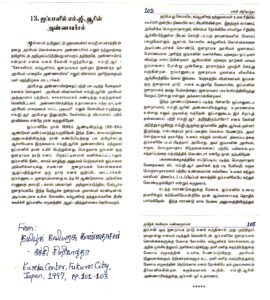Two Peculiar Thought Balloons: Annaism and Tattoos
by Sachi Sri Kantha, September 30, 2021
Fellow MGR biographer R. Kannan’s expert comments on the previous chapter Part 61, received by email of July 7, 2021, are as follows:
“Sachi,
Read your piece with interest. MGR’s use of the interchangeable spelling of his names in the initial periods and the Vikatan cartoons make this issue attractive. The events of that period are well captured including MGR’s US and the less spoken of USSR visit. The numbers of MLAs that joined MGR were no more than 16. But I have not been able to find out exactly who joined when and so not sure about the stats. We don’t know if Indira Gandhi wished for MGR to be part of her Congress. Gundu Rao who was just an MLA at that point had made an overture and is on record that MGR was not averse provided an inquiry commission was set up against his political nemesis. We will never know if this would have come to pass. For a colossus like MGR being a part of the Congress would have been a major climb down. His independence would have been greatly curtailed. As his own boss MGR waded the political waters skillfully and reading his responses in the assembly he was indeed an astute politician. Dame luck favored him every time his stock fell low but it was at the cost of his health.”
Kannan’s reply was well taken and quite correct indeed. Here is my take. After she imposed the Emergency, under Article 352, on the morning of June 26, 1975, Indira Gandhi faced protests from all the states (including Tamil Nadu). She badly needed support from her allies. But it was beyond her dignity to ask MGR to join her party.

R.K. Laxman cartoon ridiculing one of Indira’s conducts
She had employed ‘carrot and stick approach’. As Kannan had written, sending feelers via intimates (Gundu Rao, later to be the Chief Minister of Karnataka state; he was a crony to son Sanjay) to MGR was the ‘carrot’approach; using Central Government officials for tax evasion issues was the ‘stick’ approach. The ‘stick’ failed to offer dividend, following the accidental death of Indira’s Cabinet pal Mohan Kumaramangalam on May 1973.
Kannan was correct to indicate that ‘MGR waded the political waters skillfully’. I evaluate that MGR had learnt from the experience of other politicos in neighboring states that once a guy is sucked into Indira’s party, he (or she, in rare circumstances) had to dance to the tune of Indira’s whims. The Chief Minister position MGR was aiming after his expulsion from the DMK, might have eluded, if he had to place all his cards in Indira’s egg basket. At the drop of a hat, Indira might have ‘sacked’ him, and appointed another unknown crony, at her whim. This ‘game’ of Indira had been immortalized by R.K. Laxman, in a period cartoon (presented nearby).
MGR needed Indira’s political support (as long as she was the Prime Minister) badly, but at the same time, he wanted to maintain his independence to be a lead player in Tamil Nadu politics. Following the death of Kamaraj in Oct 2, 1975, MGR was in an unassailable position to replace Karunanidhi as the chief minister, and he didn’t wish to forfeit this opportunity by a false step.
An interview to BBC Tamil Oosai program about his visit to Soviet Union
In the previous chapter, I presented briefly MGR’s visit to Soviet Union in July 1973, to attend the 8th Moscow International Film Festival (MIFF). Subsequently, I was able to locate an interview MGR had given to BBC Tamil Oosai program in late July 1973, after he had landed in London. The interviewer was one Krishnamurthy. The available Youtube clip is https://www.youtube.com/watch?v=pGHd3OgLCaE
Only 10 minutes is available. I provide a transcription what MGR had spoken in Tamil. To the question, on the purpose of his Moscow visit, MGR had mentioned that, he was invited for the Film Festival, twice previously. First time in 1967, and second time in 1971. He mentions that, as he was recuperating from the shooting incident by an opposition party individual, he couldn’t make use of the 1967 invitation. And in 1971, the Tamil Nadu State elections related issues interfered, as he had to participate in DMK party activities. Only in 1973, he was ‘relatively free’ from other assignments and a need; he wished to find out something about the politics, State and people. Thus, he was able to accept the invitation. MGR also mentions that though his movies were NOT in the competition program, two of his movies were shown – Ulagam Suttrum Vaaliban (1973) and Rickshawkaran (1971) to the delegates, at the non-competition segment. He also mentions about a discussion for a collaborative movie venture between MGR Pictures and a Russian movie industry company. Eventually, nothing came out of this proposed Russia-India collaborative venture.
To the other questions, MGR answered as follows:
- This was his first visit to London, and was invited by few friends and those who were involved in the film community. His previous visits to foreign countries were to Japan, Hongkong, Bangkok and Singapore, during the shooting of Ulagam Suttrum Vaaliban.
- MGR mentions about his interest in the pre-Independent struggle as a Congress Party volunteer.
- Briefly, he also describes his birth in Kandy, Ceylon, his parents, and how his family became poor due to the custom of matrilineal inheritance (Marumakkathayam) then prevailing in Kerala state. A Wikipedia entry indicates that this particular system of inheritance was abolished by the Joint Family Stem (Abolition) Act, 1975, by the Kerala State Legislature.
- To a question about any particular British scholar (living or dead), who had influenced his thoughts and actions, MGR failed to respond directly. But, it is evident from a brief clip from his own ‘Ulagam Suttrum Valiban’ movie, philosopher Bertrand Russell was one who had some influence on him.

MGR surrounded by his personal body guards, showing their tattooed hands (1976)
Two Peculiar Thought Balloons of MGR
Two peculiar thought balloons of MGR – Annaism concept (1973) and party member identification by tattoos (1976) did receive much flak and ridicule from fellow politicians, journalists and satirists like Cho Ramaswamy. Let me, evaluate the pros and cons of these two peculiar thought balloons of MGR. First, the word ‘Annaism’ needs a definition, in the context it is used here. This is because, it is NOT defined in the print dictionaries, as of 2000. But, when one googles ‘Annaism’ now, many different meanings crop up, used in different contexts. In 1973, MGR introduced the ‘political philosophy’ of his newly found party as Annaism. It was derived from the name of his political mentor C.N. Annadurai (1909-1969), who was popularly known as Anna. This was adopted in imitation to Marxism, Leninism, Stalinism, Maoism and Castroism. These five have been defined in the American Heritage Dictionary (4th ed., 2000), but NOT Gandhism, a similar usage popular mostly in India.
‘ANNAISM’ (1973)
One may call this as a political stunt to fool the gullible, but none can fault MGR for lack of originality. Whereas hundreds of politicians in India made their living by pouting ‘foreign-derived’ concepts of democracy, liberalism, socialism, Marxism and Maoism in the parliament and public media, MGR proposed his own concept of Annaism, on September 29, 1973 at a press meet in Chennai. A 29-page policy statement booklet was distributed. According to Saidai S. Duraisamy, a founder member of Anna DMK party, those who contributed prominently in shaping the policy statement were, Nanjil K. Manoharan (1929-2000, then holding the No.2 rank in the party), R.M. Veerappan (b. 1926), S.R. Erada (1934-2020), Alandur Mohanarangam (1934- ) and K.A. Krishnaswamy (1932-2010). Asked by the reporters for clarification, MGR described Annaism as ‘a blend of the fine aspects of Gandhism, communism and capitalism’. Seven prominent features included in the released pamphlet were,
Establishment of a casteless and classless society
Advocacy that the sale of all essential commodities to be taken over by the government
A celing on income of individuals
Advocacy of demonetization of currencies above 100 rupees
People’s right to recall elected representatives if they fail to discharge their duties
Government take over of heavy industries and mills.
Nationalization of coffee, tea and rubber plantations.

Annaism – policy pamphlet Sept 29, 1973
One aspect in the policy pamphlet (i.e, so-called black money) could be traced to MGR’s past personal dealings related to his primary career as a film actor. In a previous chapter, I had described the influence of black money in the Indian movie industry [see, https://sangam.org/mgr-remembered-part-29/] In a 2012 White paper by the Indian Ministry of Finance, black money is defined as assets or resources that have neither been reported to the public authorities at the time of their generation nor disclosed at any point of time during their possession. According to an old authoritative history on ‘Indian Film’ (1980), by Barnouw and Krishnaswamy, black money ‘invaded’ the movie industry in 1940s, when MGR was a struggling actor in Tamil movies, and “to receive part of one’s salary ‘in black’ was a badge of distinction. The rumor that this or that star received 75 percent of his salary ‘in black’ and only 25 percent ‘in white’ came to be heard frequently in trade circles, and contributed to the star’s prestige and bargaining power.” Annaism policy of MGR stated, “Black money has been hanging in our economy like leprosy. Only if black money is released, we can save the country. The only way to do is to withdraw the currencies about 100. Through this, we can check the economic down trend which is rushing to the lowest ebb, at least temporarily.”
And the ‘Gandhism and communism’ segments of the tripartite frame of Annaism, could be explained as sops to his then political allies: Congress Party nationalists led by Indira Gandhi, and the Communist Party of India (CPI) represented by M. Kalyanasundaram (1909-1988). Despite the word play joke on Annaism (Anna in Tamil, literally means elder brother), made by satirist Cho Ramaswamy as ‘Appaism’ (Appa in Tamil means father or grandfather), in a Sivaji Ganesan movie Thangapathakkam (1974, Gold Medal), I have a different view on Annaism, which I had written in 1997 in my short essay collection on Kannadasan. It was titled, ‘MGR’s Annaism in Japan’. I reproduce a translation of what was presented in that book.
“All know that former Tamil Nadu chief minister M.G. Ramachandran introduced Annaism as his political philosophy. To the question, ‘What is Annaism?’, many would not have forgotten his reply – A political path combining socialism, communism and democracy is what is Annaism.
At that time, many literati ridiculed Annaism. Political commentators strongly criticized MGR’s ignorance. A question was raised, ‘Can anyone show an example of a country, in which such type of Annaism is practised?’ I don’t think that MGR himself failed to respond in detail to this question.

MGR’s Annaism in Japan (1997) – a short chapter
I have been living in Japan continuously (excluding the two years 1989-90). What I had found out in this long term residency in Japan may surprise many Tamils. MGR’s Annaism principle lives in Japan. Though Japan is generally considered as a democracy by foreigners, those who have lived in Japan for long will not compare the democracy of Japan as equal to that of America. The democracy of Japan is an enameled version of democracy introduced by American general Douglas MacArthur. If one scratches this enameled democracy, one can notice the attraction of socialism and communism principles in Japanese society.
Currently the socialism and communism principles had lost their luster at global level. American economy and the propaganda strength of the media for commercialization are the reasons. But, based on socialism and communism principles, how Japan had grown with an enameled version of democracy is appreciated by many foreigners. Other Asian countries also attempt their best to imitate Japan. There is no single word in English, to describe the Japan’s democratic enamel. Western commentators, while indicating that Japan is a democracy, also recognize that the democracy of Japan differs from that of the democracy of their western nations.
After studying these varied interpretations, I came to recognize that could it be that the democracy of Japan is an example of MGR’s Annaism. Then, a question raises, whether MGR had learnt about Japan’s specialty. We need to recognize that MGR was much interested in Japan. He shot his own ‘Ulagam Sutrum Vaaliban’ movie in Japan. I believe that during that time, he might have learnt something about the politics, society and economic thoughts of Japan.
One may think that compared to the [theoretical base] economists who studied in the university, MGR went a step further and did learn [practical aspects] about the societal economic wealth of Japan, while shooting his Ulagam Suttrum Vaaliban movie.
For the past two years, I have been working in a Japanese food company as a researcher. I came to learn from this work experience that it’s a big mistake to consider Japan is a democracy. In Japan, socialist, communist principles are given higher priority in preference to democratic principles. Societal growth and uplift is respected more than the freedom of an individual. Political institutions and judiciary also give high priority to the societal welfare in preference to individual freedom. In brief, Japan is an example for MGR’s Annaism.”
Subsequently, in November 2006, following the death of economist Milton Friedman, I contributed an essay captioned ‘On Milton Friedman, MGR & Annaism’ to this website.
[https://www.sangam.org/taraki/articles/2006/11-25_Friedman_MGR.php?uid=2075]. While I had tagged that ‘MGR’s Annaism balloon was an entertaining distraction’, I summed up that “even Milton Friedman had provided evidence MGR had got it right in 1973; that capitalism and socialism could co-exist.” I refrain from reproducing what was written in that essay here.
Now in 2021, after living in Japan for 33 years, I’d assert that I will not change a line on what I wrote in 1997, about the prevalence of Annaisn in Japan with an amendment. If I were asked whether Japan’s economic prosperity could be reproduced in Tamil Nadu or elsewhere, by following the Annaism political philosophy, my answer is NO. Japan’s economic prosperity in the 2nd half of the 20th century was due to multiple factors; (1) special treatment it received from American policy planners during the presidency of Truman and Eisenhower, to establish a ‘one –party state’ that continues to hold power since 1955. (2) Japan being a vassal state of USA, in military affairs, and (3) Vietnam war of 1960s. These conditions will not recur anywhere else now. Last but not the least, as in every nation, political greed and corruption are rampant in Japan as well.
Tattooing of Party Members
MGR’s ‘double’ cum body-guard, K.P. Ramakrishnan (who is seated to MGR’s left), in the photo presented nearby), provides some background information about MGR’s idea and wish for party members to have a party tattoo in one’s hand. I provide a translation:
“MGR wished that all members of the All India Anna DMK party to have the party flag with Annadurai’s face tattooed in their hand permanently. A nearly 60 year old tattoo artist was invited to the MGR’s office located at the Mambalam Arkadu Mudali Road. He brought a battery-operated nail-like instrument for placing tattoos.It took 10 minutes to complete one cycle of tattooing, with AIADMK flag having Anna’s face. Prior to the tattooing step, this guy first draw the image of the flag in the hand.
MGR was the first to complete tattooing. Then, he asked me to complete the act. The third one was Nanjil Manoharan. 4th was P.T. Saraswathi. Following that, stunt workers in MGR’s team Dharmalingam, Thandapani, Sarathi, Alagirisami, Scene Muthu (that’s his name, because he was in charge of scene settings for the dramas) completed tattooing. Like what happened at the Mambalam office, tattooing was carried out in the many districts of Tamil Nadu and many cities.
K.A. Krishnaswamy, Kalimuthu, R.M. Veerappan, Ponnaiyan, Raja Mohamad, Edmund, Navalar Nedunchezhiyan, K. Rajaram, Aranganayakam, Muthusami, Koventhan, Kulandaivelu, S. Thirunavukarasu (now, Thirunavukkarasar), who later became ministers completed tattooing. As far as I know, only one individual who told MGR that he don’t want to have this tattoo, was Kovai Chezhiyan. He had produced many Tamil movies.
Once tattooing is completed, it is not easy to erase it. Only by burning, it could be erased, and a painful effort. When Nanjil Manoharan left AIADMK party and returned to DMK party, he attempted to erase that tattoo, but failed. Next to Manoharan, Mudakurichi Subbulakshmi Jegatheesan also left AIADMK, and joined the DMK party.
The old tattoo artist was paid ten rupees per person. Following that, he had a good demand for his job. To respect MGR’s word, hundreds of thousands of party workers completed this tattooing project. MGR didn’t force it. He believed that by this act, party cadres would gain an affinity, and cooperative feeling when they meet at different locations. Once identified with a party tattoo, there may be reluctance for some who wish to jump to other party, as well. MGR thought that, party tattoo could function as a ‘passport’ to recognize fellow workers and build helping spirit and receiving help from those who carry the same tattoo in other cities and other states.”
Biographer Kannan had also added the names of G.Viswanathan, P. Srinivasan and Dr. H.V. Hande, in addition to Kovai Chezhiyan, who had expressed their opposition to tattooing of party flag in their hands. As a consequence, MGR did expel Kovai Chezhian, Viswanathan and Srinivasan from the party.
To place this tattoo issue in overall perspective, tattooing has had a long history in many cultures for varied purposes, including that of early Christians and Japanese Shintoists cum Buddhists. Kris Perry had recorded a historical fact about early Christians, which was done for the similar purpose MGR wished his party members would be willing to acquiesce. To quote, “In the years immediately after Christ, tattooing achieved a special significance to followers of the Christian faith. They tattooed certain symbols on their arms or hands that allowed other faithful to recognize them, without risking death at the hands of their Roman persecutors.” This practice continued for over seven centuries, until AD 787, when tattooing was banned through a Papal edict.
It could be anybody’s guess, whether MGR had read (or probably heard) about this early Christian practice, and wished to emulate it for similar reasons of persecution of his followers from the harassers belonging to the parent DMK party. Until MGR’s breakaway party captured power in 1977, in the five year span (1973-mid 1977), there had been incidences of death threats, even to the leaders of Anna DMK party from DMK affiliated rowdy elements.
Coda
Mahatma Gandhi promoted two idiosyncratic concepts – ‘sampoorna swarajya’ (Complete Independence) and ‘Ram Rajya’ (The Giovernment of Rama). Unlike other foreign-born political concepts of democracy, socialism and communism, both turned out to be mirages. Mere mention of the Hindu God Rama, alienated Muslims. Akin to Gandhi’s ‘Ram Rajya’, MGR’s peculiar concept of Annaism also failed to fly for its impracticality and MGR himself had given it up at the end of his first tenure of chief ministership by early 1980.
Cited Sources
Barnouw and S. Krishnaswamy: Indian Film, 2nd ed., Oxford University Press, New York, 1980, pp. 127-129.
Express News Service: When Annaism sought de-monetization. The New Indian Express, Aug 15, 2017.
Kannan: MGR – A Life, Penguin Random House, India, Gurgaon, Haryana, 2017.
P. Ramakrishnan: MGR – Oru Sahabtham, Viktan Pirasuram 155, 8th ed., Chennai, 2013, pp. 143-145. (in Tamil).
Sperry: Tattoos and Tattooing. Part 1: History and Methodology. American Journal of Forensic Medicine and Pathology, 1991; 12(4): 313-319.
Sri Kantha: Japan –il MGR in Annaism, ch. 13, Tamil Kavi Arasu Kannadasan, Eureka Center, Fukuroi City, Japan, 1997, pp. 101-103. (in Tamil)
Sri Kantha: On Milton Friedman, MGR & Annaism. https://www.sangam.org/taraki/articles/2006/11-25_Friedman_MGR.php?uid=2075 [accessed Oct. 1, 2021].
Nice article indeed which evoked my early memories of MGR’s political moves in particular his unique idea of tattooing. The part to be appreciated is he did it on his hands first! I remember how much self serving people like Cho made fun of it. Also I remember that there was a case filed to prohibit people with that tattoo from voting since it can be considered as equivalent of campaigning with a party symbol near a polling booth which is not allowed per law. Finally the judge ruled that by wearing a full hand shirt the tattoo should be concealed to enter the polling booth, another victory to MGR!